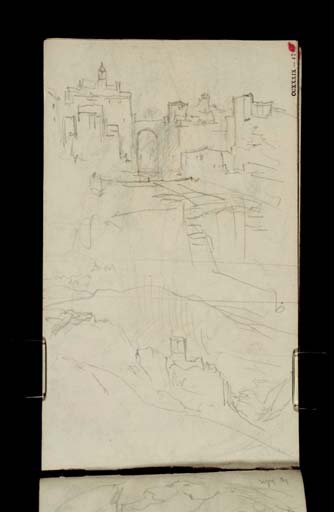Joseph Mallord William Turner The Shropshire Union Canal Cutting with the Bridge of Sighs, Chester; Peveril Castle from the South-East ?1831
Image 1 of 2
-
 Joseph Mallord William Turner, The Shropshire Union Canal Cutting with the Bridge of Sighs, Chester; Peveril Castle from the South-East ?1831
Joseph Mallord William Turner, The Shropshire Union Canal Cutting with the Bridge of Sighs, Chester; Peveril Castle from the South-East ?1831 -
 Joseph Mallord William Turner, The Shropshire Union Canal Cutting with the Bridge of Sighs, Chester; Peveril Castle from the South-East ?1831 (Enhanced image)Enhanced image
Joseph Mallord William Turner, The Shropshire Union Canal Cutting with the Bridge of Sighs, Chester; Peveril Castle from the South-East ?1831 (Enhanced image)Enhanced image
Joseph Mallord William Turner,
The Shropshire Union Canal Cutting with the Bridge of Sighs, Chester; Peveril Castle from the South-East
?1831
Joseph Mallord William Turner 1775–1851
Folio 47 Recto:
The Shropshire Union Canal Cutting with the Bridge of Sighs, Chester; Peveril Castle from the South-East ?1831
D22237
Turner Bequest CCXXXIX 47
Turner Bequest CCXXXIX 47
Pencil on white wove paper, 191 x 114 mm
Inscribed by Turner in pencil ‘[?D...]’ centre left
Inscribed by John Ruskin in red ink ‘47’ top right, ascending vertically
Stamped in black ‘CCXXXIX – 47’ top right, ascending vertically
Inscribed by Turner in pencil ‘[?D...]’ centre left
Inscribed by John Ruskin in red ink ‘47’ top right, ascending vertically
Stamped in black ‘CCXXXIX – 47’ top right, ascending vertically
Accepted by the nation as part of the Turner Bequest 1856
References
1909
A.J. Finberg, A Complete Inventory of the Drawings of the Turner Bequest, London 1909, vol.II, p.735, CCXXXIX 47, as ‘Peveril’s Castle; also group of buildings’.
There are three sketches here, with those above and below made with the page turned vertically. The top view is along the Shropshire Union Canal cutting at Chester, with the Bridge of Sighs below the cupola of the Bluecoat School on Northgate, looking east. The narrow footbridge was built in 1793 to link Northgate Gaol and the Chapel of Little St John (both gone), and was redundant by the time of Turner’s visit, although it survives just to the west of Northgate Bridge;1 the two are perhaps conflated in this slight sketch, but they are clearly differentiated in a similar view on folio 60 recto (D22261), together with one in the opposite direction. Turner’s attention might have been caught by the structure’s name, presumably after its famous counterpart in Venice, which he recorded in 1819 in the Milan to Venice sketchbook (Tate D14388; Turner Bequest CLXXV 39a) and on subsequent visits in 1833 and 1840.2
A comparable viewpoint today is St Martin’s Way, from which later buildings on the left and trees on the right partly obscure the view. Across the central register of the page is a sketch made with the page inverted relative to the sketchbook’s foliation, apparently showing the buildings along the city walls above the south side of the canal, corresponding to the shaded area of the first sketch. For other views of Chester, see under folio 14 verso (D22176). Ian Warrell has compared the motif of the bridge over a gorge to that in a watercolour vignette of the 1830s known as ‘An Italian Castle above a River’ (private collection),3 although the resemblance is presumably fortuitous.
Matthew Imms
April 2014
See Steve Howe, ‘The Northgate Part II’, Chester: A Virtual Stroll around the Walls, accessed 9 January 2013, http://www.chesterwalls.info/northgate2.html .
See Ian Warrell, Turner and Venice, exhibition catalogue, Tate Britain, London 1993, pp.77, 115–16, 131.
Ian Warrell, notes from 1993 and later in Tate catalogue files, suggesting the present subject as Bolsover Castle, Derbyshire (not otherwise known as a Turner subject) or Chester; not in Andrew Wilton, J.M.W. Turner: His Life and Work, Fribourg 1979; see ‘Turner News and Notes’, Turner Society News, no.37, September 1985, p.2, reproduced (upside down).
How to cite
Matthew Imms, ‘The Shropshire Union Canal Cutting with the Bridge of Sighs, Chester; Peveril Castle from the South-East ?1831 by Joseph Mallord William Turner’, catalogue entry, April 2014, in David Blayney Brown (ed.), J.M.W. Turner: Sketchbooks, Drawings and Watercolours, Tate Research Publication, September 2014, https://www

